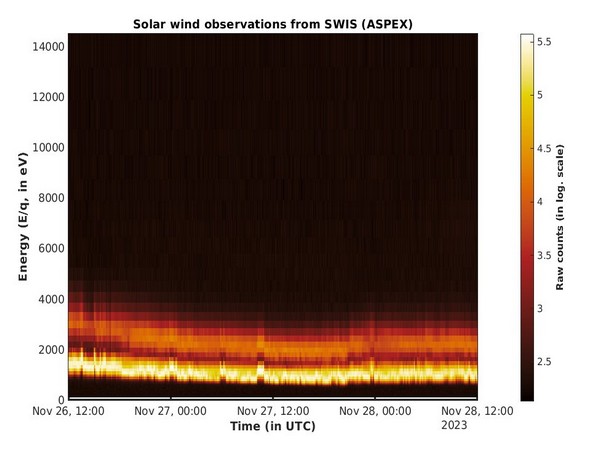
Aditya-L1 mission: Solar wind ion spectrometer becomes operational

New Delhi [India], December 2 (ANI): The Indian Space Research Organisation informed on Saturday that the Solar Wind Ion Spectrometer (SWIS), the second instrument in the Aditya Solar Wind Particle Experiment (ASPEX) of its maiden solar mission, Aditya L1 is operational.
“The Solar Wind Ion Spectrometer (SWIS), the second instrument in the Aditya Solar Wind Particle Experiment (ASPEX) payload is operational. The histogram illustrates the energy variations in proton and alpha particle counts captured by SWIS over 2-days,” ISRO said in a post on X.
As per a statement issued by ISRO, the Aditya Solar Wind Particle Experiment (ASPEX) payload onboard India’s Aditya-L1 satellite is performing normally.
ASPEX comprises two cutting-edge instruments – the Solar wind Ion Spectrometer (SWIS) and STEPS (SupraThermal and Energetic Particle Spectrometer).
The STEPS instrument became operational on September 10, 2023. The SWIS instrument was activated on November 2, 2023, and has exhibited optimal performance, the statement mentioned.
ISRO further stated that the ASPEX has begun its measurements of solar wind ions.
“SWIS, utilizing two sensor units with a remarkable 360° field of view each, operates in planes perpendicular to one another. The instrument has successfully measured solar wind ions, primarily protons and alpha particles,” the statement said.
“A sample energy histogram acquired from one of the sensors over two days in November 2023 illustrates variations in proton (H+) and alpha particle (doubly ionized helium, He2+) counts. These variations were recorded with nominal integration time, providing a comprehensive snapshot of solar wind behaviour,” it added.
The directional capabilities of SWIS enable precise measurements of solar wind protons and alphas, contributing significantly to addressing longstanding questions about solar wind properties, underlying processes, and their impact on Earth, ISRO said.
The statement added that as researchers delve deeper into the collected data, the international scientific community eagerly awaits the wealth of knowledge that Aditya-L1’s ASPEX is set to unveil about the enigmatic solar wind and its implications for our planet.
In its update, ISRO on November 7, Tuesday, noted that the spectrometer on board Aditya-L1 recorded the impulsive phase of solar flares, during its first observation period from approximately October 29, 2023.
The X-ray spectrometer, HEL1OS, attached to the Aditya-L1 spacecraft captured the first high-energy X-ray glimpse of solar flares.
A solar flare is a sudden brightening of the solar atmosphere. Flares produce enhanced emission in all wavelengths across the electromagnetic spectrum – radio, optical, UV, soft X-rays, hard X-rays and gamma-rays.
Commissioned on October 27, 2023, the HEL1OS X-ray spectrometer is currently undergoing fine-tuning of thresholds and calibration operations. It has been monitoring the Sun for hard X-ray activities ever since.
In early October, the Aditya-L1 spacecraft that is carrying out India’s first solar mission performed a trajectory correction manoeuvre (TCM), for about 16 seconds.
ISRO then noted that the manoeuvre was needed to correct the trajectory evaluated after tracking the Trans-Lagrangean Point 1 Insertion (TL1I) manoeuvre performed on September 19.
After the successful soft landing of Chandrayaan-3 near the South pole of the moon, the ISRO launched the country’s maiden solar mission — Aditya-L1 from the Satish Dhawan Space Centre in Sriharikota on September 2.
ISRO had said Aditya-L1 will neither land on the sun nor approach the sun any closer.
This strategic location will enable Aditya-L1 to continuously observe the sun without being hindered by eclipses or occultation, allowing scientists to study solar activities and their impact on space weather in real-time.
Also, the spacecraft’s data will help identify the sequence of processes that lead to solar eruptive events and contribute to a deeper understanding of space weather drivers. (ANI)

















POST COMMENTS (0)